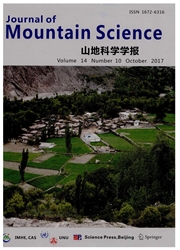

 中文摘要:
中文摘要:
不同地形条件下植被覆盖分布差异明显,对地形因子空间格局进行研究有助于更好地理解和掌握植被覆盖格局的形成机制.本文基于北京一号卫星遥感影像和数字高程模型,结合地统计分析和分形分析方法,开展福建省植被指数(NDVI)与地形因子空间格局的多尺度研究.结果表明:NDVI、坡度与坡向在小尺度范围内空间格局变化明显,其中450m是坡度和坡向空间格局发生重大改变的一个转折点,而高程的空间格局在小尺度范围内相对比较稳定,其Moran’s I指数与坡度、坡向相比最大,表明福建省地形的空间结构主要是由高程来决定的;NDVI的Moran’s I指数在5220m处出现谷值,表明在小于该尺度的地方可能存在NDVI单元,而坡度的Moran’s I指数也在5220m处出现谷值,表明坡度可能对NDVI单元的形成具有重要作用,NDVI及地形要素的分形维数变化曲线均在5220m处出现谷值,一定程度上说明地形要素较为规则的空间分布可能对NDVI单元的形成具有一定的影响.
 英文摘要:
英文摘要:
Topographic factors play an important role in control ing the distribution of vegetation pattern. In order to better understand the formation mechanism of vegetation pattern, a multi-scale study on the spatial patterns of the normalised difference vegetation index (NDVI) and topographic factors in Fujian Province was conducted using geostatistic and fractal methods based on Beijing-1 satel ite imagery and digital elevation models. Results show that the spatial pattern of the NDVI, slope and aspect change signiifcantly within a smal-scale extent, and 450 m is a marker indicating changes in the spatial pattern of slope and aspect. In contrast, elevation has a relatively stable spatial pattern within a smal-scale extent. Moran’s I of NDVI and slope both had val ey values of 5220 m, suggesting that spatial patterns of NDVI correspond to those of slope at these two scales. Fractal dimension curves of NDVI and topographic factors appear at 5220 m in the val ey, which shows that a more regular spatial distribution of topographic factors have a certain inlfuence on the formation of NDVI units to some extent.
 同期刊论文项目
同期刊论文项目
 同项目期刊论文
同项目期刊论文
 Multilevel Assessment of Spatiotemporal Variability of Vegetation in Subtropical Mountain-hill Regio
Multilevel Assessment of Spatiotemporal Variability of Vegetation in Subtropical Mountain-hill Regio Characterizing Spatiotemporal Non-Stationarity in Vegetation Dynamics in China Using MODIS EVI Datas
Characterizing Spatiotemporal Non-Stationarity in Vegetation Dynamics in China Using MODIS EVI Datas Spatiotemporal variability of vegetation phenology with reference to altitude and climate in the sub
Spatiotemporal variability of vegetation phenology with reference to altitude and climate in the sub Comparative spatio-spectral heterogeneity analysis using broadband and hyperspectral airborne images
Comparative spatio-spectral heterogeneity analysis using broadband and hyperspectral airborne images 期刊信息
期刊信息
